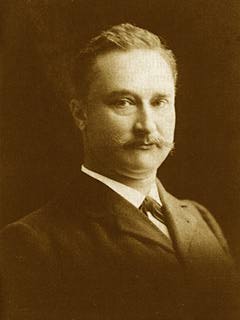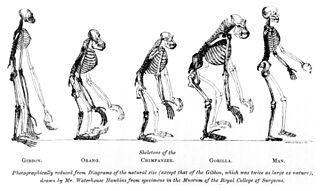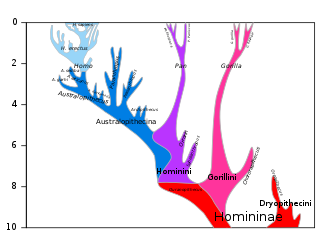
Darwinism is a theory of biological evolution developed by the English naturalist Charles Darwin (1809–1882) and others, stating that all species of organisms arise and develop through the natural selection of small, inherited variations that increase the individual's ability to compete, survive, and reproduce. Also called Darwinian theory, it originally included the broad concepts of transmutation of species or of evolution which gained general scientific acceptance after Darwin published On the Origin of Species in 1859, including concepts which predated Darwin's theories. English biologist Thomas Henry Huxley coined the term Darwinism in April 1860.

Ernst Heinrich Philipp August Haeckel was a German zoologist, naturalist, eugenicist, philosopher, physician, professor, marine biologist, and artist who discovered, described and named thousands of new species, mapped a genealogical tree relating all life forms, and coined many terms in biology, including ecology, phylum, phylogeny, and Protista. Haeckel promoted and popularised Charles Darwin's work in Germany and developed the influential but no longer widely held recapitulation theory claiming that an individual organism's biological development, or ontogeny, parallels and summarises its species' evolutionary development, or phylogeny.

The Piltdown Man was a paleoanthropological fraud in which bone fragments were presented as the fossilised remains of a previously unknown early human. Although there were doubts about its authenticity virtually from the beginning, the remains were still broadly accepted for many years, and the falsity of the hoax was only definitively demonstrated in 1953. An extensive scientific review in 2016 established that amateur archaeologist Charles Dawson was responsible for the fraudulent evidence.

Marie Eugène François Thomas Dubois was a Dutch paleoanthropologist and geologist. He earned worldwide fame for his discovery of Pithecanthropus erectus, or "Java Man". Although hominid fossils had been found and studied before, Dubois was the first anthropologist to embark upon a purposeful search for them.
Paleoanthropology or paleo-anthropology is a branch of paleontology and anthropology which seeks to understand the early development of anatomically modern humans, a process known as hominization, through the reconstruction of evolutionary kinship lines within the family Hominidae, working from biological evidence and cultural evidence.

Java Man is an early human fossil discovered in 1891 and 1892 on the island of Java. Estimated to be between 700,000 and 1,000,000 years old, it was, at the time of its discovery, the oldest hominid fossils ever found, and it remains the type specimen for Homo erectus.

Craniometry is measurement of the cranium, usually the human cranium. It is a subset of cephalometry, measurement of the head, which in humans is a subset of anthropometry, measurement of the human body. It is distinct from phrenology, the pseudoscience that tried to link personality and character to head shape, and physiognomy, which tried the same for facial features. However, these fields have all claimed the ability to predict traits or intelligence.

Mrs. Ples is the popular nickname for the most complete skull of an Australopithecus africanus ever found in South Africa. Many Australopithecus fossils have been found near Sterkfontein, about 40 kilometres (25 mi) northwest of Johannesburg, in a region of Gauteng now designated as the Cradle of Humankind World Heritage Site. Mrs. Ples was discovered by Robert Broom and John T. Robinson on April 18, 1947. Because of Broom's use of dynamite and pickaxe while excavating, Mrs. Ples's skull was blown into pieces and some fragments are missing. Nonetheless, Mrs./Mr. Ples is one of the most "perfect" pre-human skulls ever found. The skull is currently held at the Ditsong National Museum of Natural History in Pretoria.

Taung is a small town situated in the North West Province of South Africa. The name means place of the lion and was named after Tau, the King of the Barolong. Tau is the Tswana word for lion.

Australopithecus africanus is an extinct species of australopithecine which lived from 3.67 to 2 million years ago in the Middle Pliocene to Early Pleistocene of South Africa. The species has been recovered from Taung and the Cradle of Humankind at Sterkfontein, Makapansgat, and Gladysvale. The first specimen, the Taung child, was described by anatomist Raymond Dart in 1924, and was the first early hominin found. However, its closer relations to humans than to other apes would not become widely accepted until the middle of the century because most had believed humans evolved outside of Africa principally due to the hoax transitional fossil Piltdown Man from Britain. It is unclear how A. africanus relates to other hominins, being variously placed as ancestral to Homo and Paranthropus, to just Paranthropus, or to just P. robustus. The specimen "Little Foot" is the most completely preserved early hominin, with 90% of the skeleton intact, and the oldest South African australopith. However, it is controversially suggested that it and similar specimens be split off into "A. prometheus".
Between 1860 and 1868, the life and work of Charles Darwinfrom Orchids to Variation continued with research and experimentation on evolution, carrying out tedious work to provide evidence of the extent of natural variation enabling artificial selection. He was repeatedly held up by his illness, and continued to find relaxation and interest in the study of plants. His studies of insect pollination led to publication of his book Fertilisation of Orchids as his first detailed demonstration of the power of natural selection, explaining the complex ecological relationships and making testable predictions. As his health declined, he lay on his sickbed in a room filled with inventive experiments to trace the movements of climbing plants.

Evidence as to Man's Place in Nature is an 1863 book by Thomas Henry Huxley, in which he gives evidence for the evolution of man and apes from a common ancestor. It was the first book devoted to the topic of human evolution, and discussed much of the anatomical and other evidence. Backed by this evidence, the book proposed to a wide readership that evolution applied as fully to man as to all other life.

The Taung Child is the fossilised skull of a young Australopithecus africanus. It was discovered in 1924 by quarrymen working for the Northern Lime Company in Taung, South Africa. Raymond Dart described it as a new species in the journal Nature in 1925.
Kenneth Page Oakley was an English physical anthropologist, palaeontologist and geologist.

Sir Richard Owen was an English biologist, comparative anatomist and paleontologist. Despite being a controversial figure, Owen is generally considered to have been an outstanding naturalist with a remarkable gift for interpreting fossils.

Graecopithecus is a hominid originally identified by a single mandible found in Nikiti, Greece in 1944. Since then, analysis of tooth specimens, dated to 7.2 million years ago, has led to suggestions that Graecopithecus may have been the oldest possible direct ancestor of humans excluding the chimpanzee lineage, or alternatively a possible last common ancestor of both humans and chimpanzees, though other scientists are skeptical of these claims. The creature was nicknamed 'El Graeco' by scientists.
The Out of Asia theory was a scientific theory that contended that modern humans first arose in Asia. Most anthropologists until the mid 20th century preferred Asia, over Africa, as the continent where the first hominids evolved. The recent African origin of modern humans theory is currently supported by more data.
The history of anthropometry includes its use as an early tool of anthropology, use for identification, use for the purposes of understanding human physical variation in paleoanthropology and in various attempts to correlate physical with racial and psychological traits. At various points in history, certain anthropometrics have been cited by advocates of discrimination and eugenics often as part of novel or based upon pseudoscience.

"Missing link" is a non-scientific term for a transitional fossil. It is often used in popular science and in the media for any new transitional form. The term originated to describe the hypothetical intermediate form in the evolutionary series of anthropoid ancestors to anatomically modern humans (hominization). The term was influenced by the pre-Darwinian evolutionary theory of the Great Chain of Being and the now-outdated notion (orthogenesis) that simple organisms are more primitive than complex organisms.

Ape to Man is a dramatised documentary on the scientific community's journey to find the missing link in human evolution, between our ancestors the apes and modern man today.















